seats CHEVROLET CAVALIER 1993 1.G Owners Manual
[x] Cancel search | Manufacturer: CHEVROLET, Model Year: 1993, Model line: CAVALIER, Model: CHEVROLET CAVALIER 1993 1.GPages: 308, PDF Size: 15.62 MB
Page 3 of 308
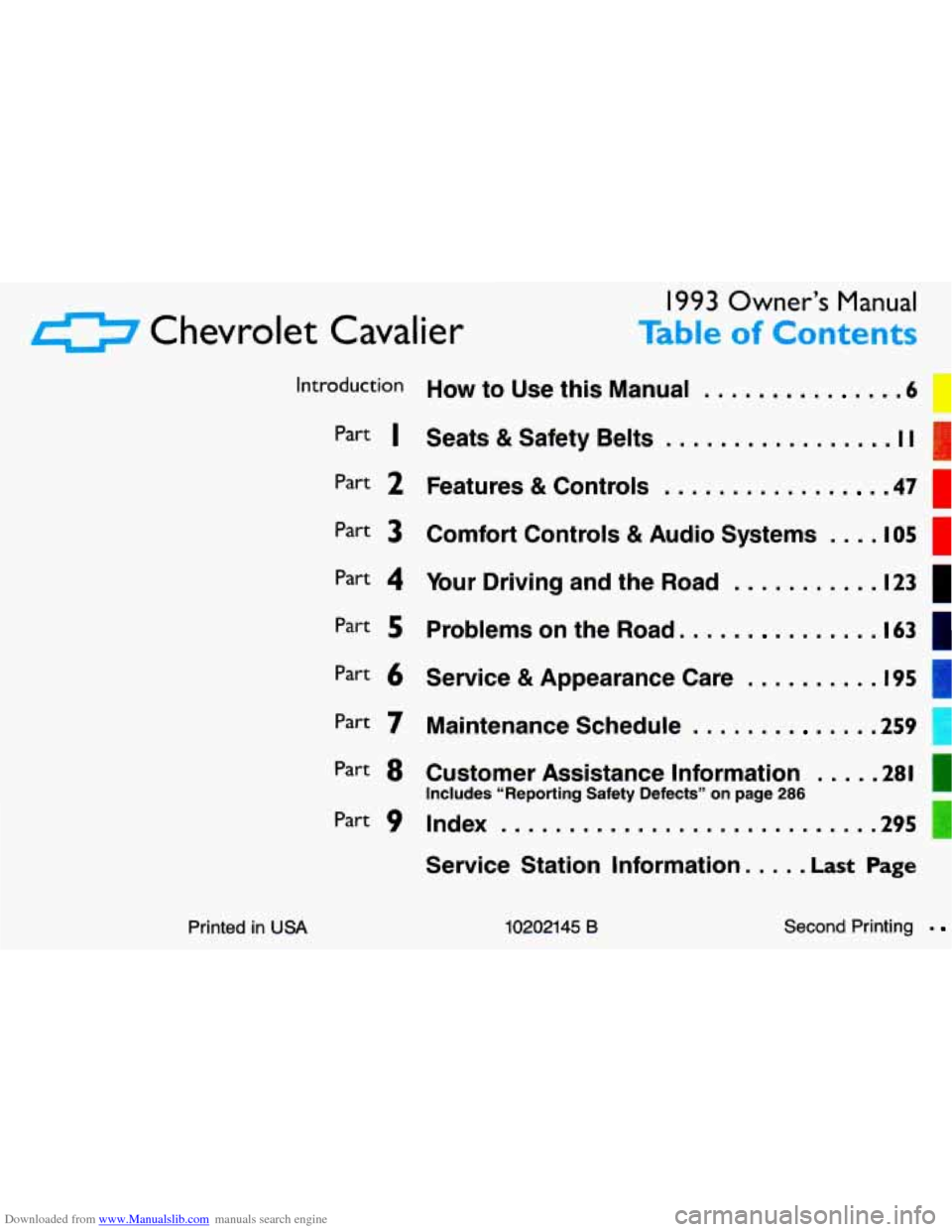
Downloaded from www.Manualslib.com manuals search engine I993 Owner’s Manual
0 Chevrolet Cavalier Table of Contents
Printed in USA
introduction How to Use this Manual . . . . . . . . . . . . 6
Part I Seats & Safety Belts , ‘I . . i, . . . . . .
Part 2 Features & Controls . . . . . . . . . . . . 47 =
Part 3
Part 4
Part 5
Part 6
Part 7
Part 8
Part 9
Comfort Controls & Audio Systems . . . I O!
Your Driving and the Road . . , . . . . . . . . 123 I
Problems on the Road. . . . . . . a . . . a
Service & Appearance Care . . . . . . . . . I95
Maintenance Schedule . . . . . . . . . . 259 r
Customer Assistance Information . . . . . 281 I
Includes “Reporting Safety Defects” on page 286
Index .................... 295
Service Station Information . . . . Last Page
10202145 B Second Printing .
Page 8 of 308
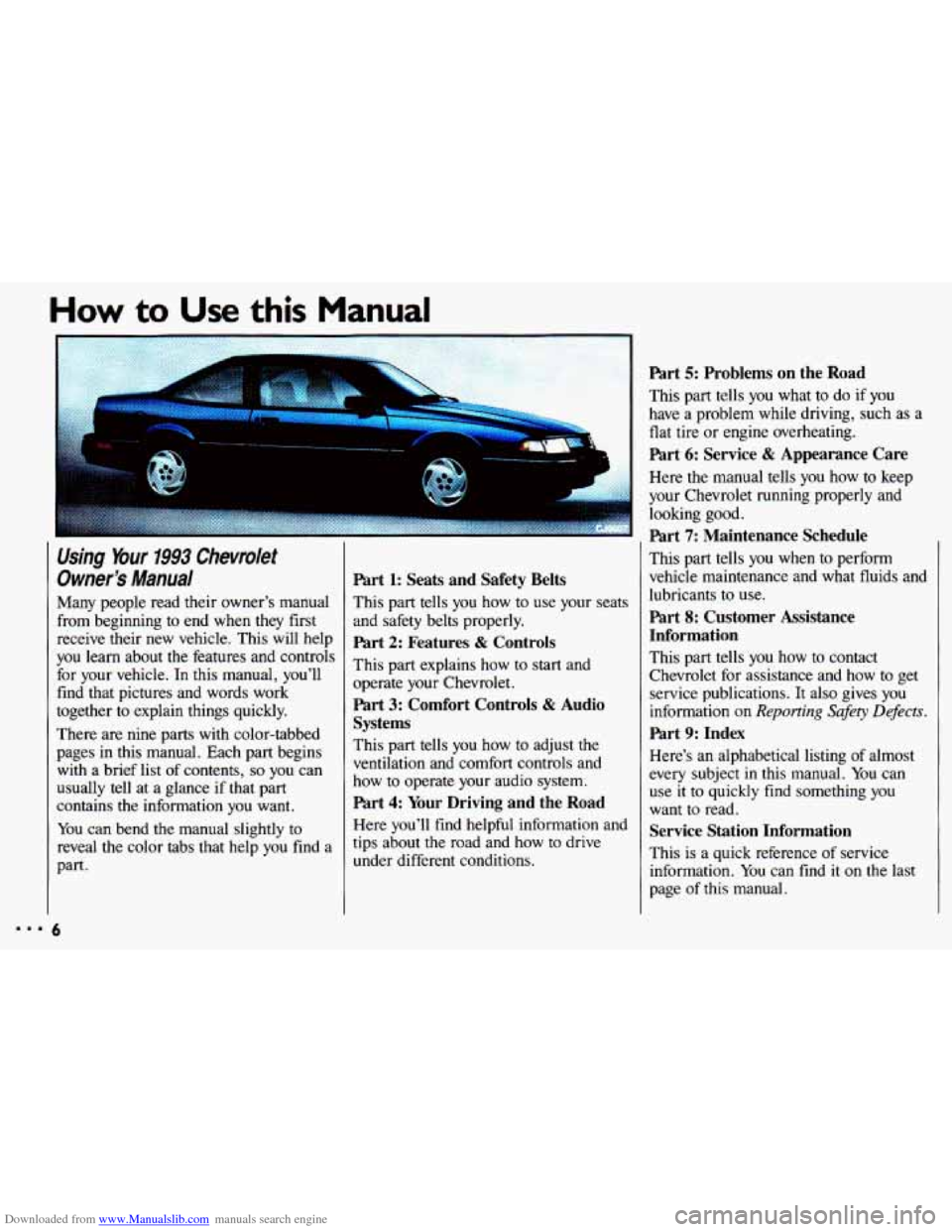
Downloaded from www.Manualslib.com manuals search engine How to Use this Manual
Using Your 1993 Chevrolet
Owner's
Manual
Many people read their owner's manual
from beginning to end when they first
receive their new vehicle. This will help
you learn about the features and controls
for your vehicle.
In this manual, you'll
find that pictures and words work
together to explain things quickly.
There are nine parts with color-tabbed
pages in this manual. Each part begins with a brief list of contents,
so you can
usually tell at a glance if that part
contains the information you want.
You can bend the manual slightly to
reveal the color tabs that help you find a
part.
5
Part 1: Seats and Safety Belts
This part tells you how to use your seats
and safety belts properly.
Part 2: Features & Controls
This part explains how to start and
operate your Chevrolet.
Part 3: Comfort Controls & Audio
Systems
This part tells you how to adjust the
ventilation and comfort controls and
how to operate your audio system.
Part 4: Your Driving and the Road
Here you'll find helpful information and
tips about the road and how to drive
under different conditions.
Part 5: Problems on the Road
This part tells you what to do if you
have a problem while driving, such as a
flat tire or engine overheating.
Part 6: Service & Appearance Care
Here the manual tells you how to keep
your Chevrolet running properly and looking good.
Part 7: Maintenance Schedule
This part tells you when to perform
vehicle maintenance and what fluids and
lubricants to use.
Part 8: Customer Assistance
Information
This part tells you how to contact
Chevrolet for assistance and how to get
service publications. It also gives you
information on
Reporting Safety Defects.
Part 9: Index
Here's an alphabetical listing of almost
every subject
in this manual. You can
use it
to quickly find something you
want to read.
Service Station Information
This is a quick reference of service
information.
You can find it on the last
page of this manual.
Page 13 of 308
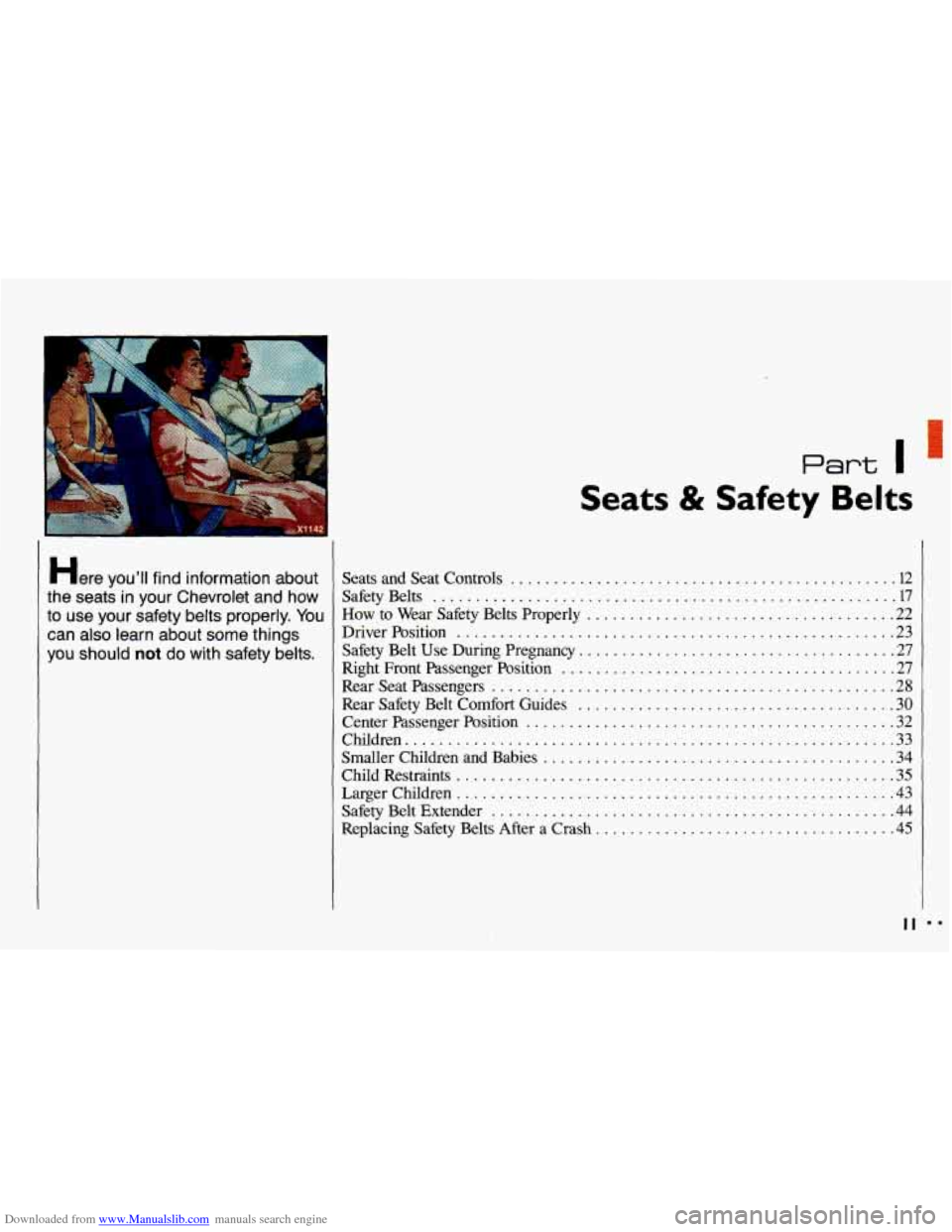
Downloaded from www.Manualslib.com manuals search engine .
Here YOU’II find information about
the seats in your Chevrolet and how
to use your safety belts properly
. You
can also learn about some things
you should
not do with safety belts .
Part I
I
Seats & Safety Belts
Seats and Seat Controls ............................................. 12
SafetyBelts ...................................................... 17
How. to Wear Safety Belts Properly .................................... 22
DriverPosition ................................................... 23
Safety Belt Use During Pregnancy ..................................... 27
Right Front Passenger Position
....................................... 27
Rear Safety Belt
Comfort Guides ..................................... 30
Center Passenger Position
........................................... 32
Children
......................................................... 33
Smaller Children and Babies
......................................... 34
Child Restraints
................................................... 35
LargerChildren ................................................... 43
SafetyBeltExtender ............................................... 44
Replacing Safety Belts After a Crash
................................... 45
RearSeatPassengers ............................................... 28
II mm
Page 14 of 308
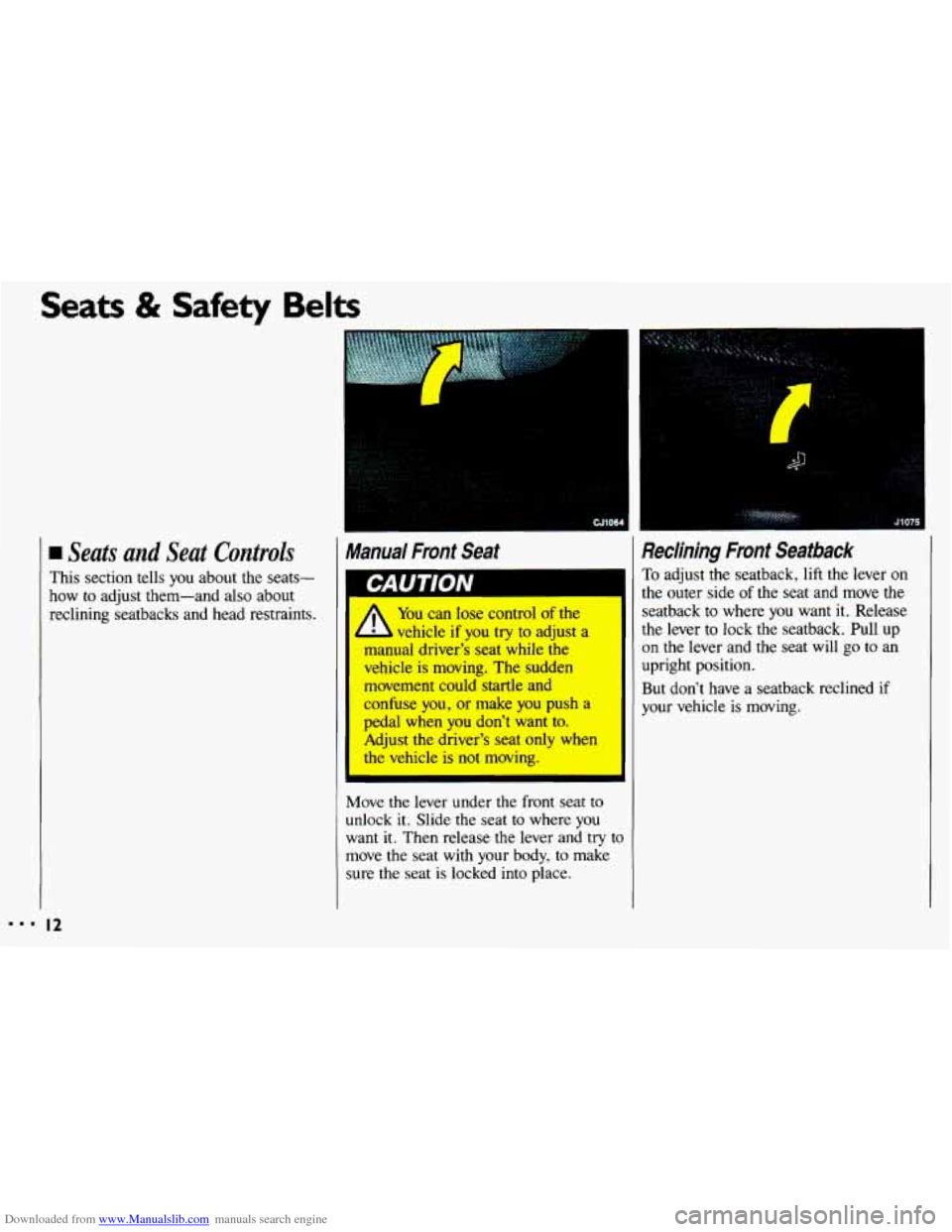
Downloaded from www.Manualslib.com manuals search engine Seats & Safety Belts
Seats and Seat Controls
This section tells you about the seats-
how to adjust them-and
also about
reclining seatbacks and head restraints.
I2
Manual Front Seat
IC"
I , You can lose control of the
- b vehicle if you try to adjust a
manual driver's seat while the
vehicle is moving. The sudden
movement could startle and
confuse you, or make
you push a
pedal when you don't want to.
Adjust the driver's seat only when
the vehicle is not moving.
Move
the lever under the front seat to
unlock it. Slide the seat to where you
want
it. Then release the lever and try tc
move the seat with your body, to make
sure the seat is locked into place.
1
,
1
1
3
Reclining Front Seatback
To adjust the seatback, lift the lever on
the outer side
of the seat and move the
seatback
to where you want it. Release
the lever
to lock the seatback. Pull up
on the lever and the seat will go to an
upright position.
But don't have a seatback reclined if
-Jour vehicle is moving.
Page 16 of 308
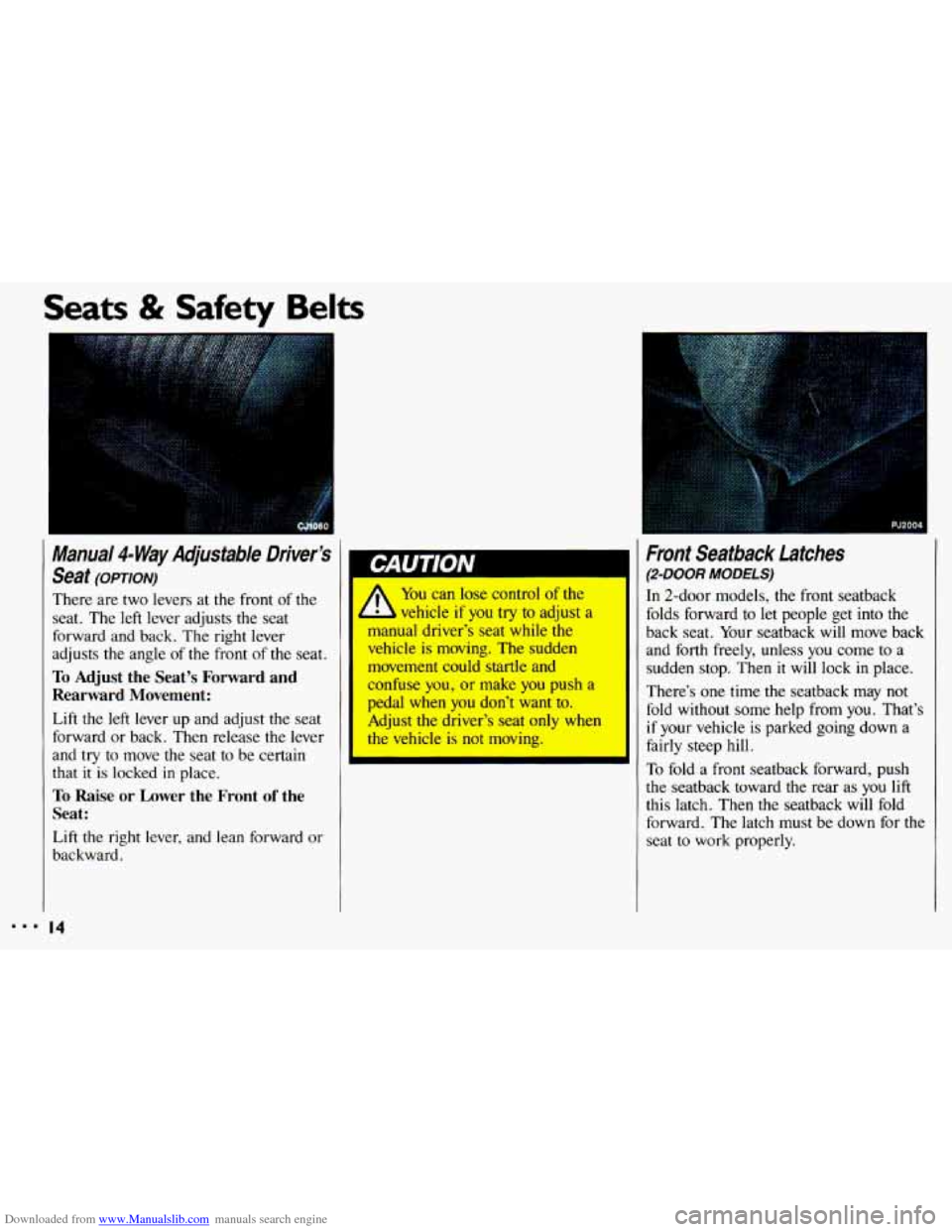
Downloaded from www.Manualslib.com manuals search engine ...
Seats & Safety Belts
Mama/ 4- Way Adjustab/e Driver’s
Seat
(OPTION)
There are two levers at the front of the
seat. The left lever adjusts the seat
forward and back. The right lever
adjusts
the angle of the front of the seat.
To Adjust the Seat’s Forward and
Rearward Movement:
Lift the left lever up and adjust the seat
forward or back. Then release the lever
and
try to move the seat to be certain
that
it is locked in place.
To Raise or Lower the Front of the
Seat:
Lift the right lever, and lean forward or
backward.
14
You can lose control of the
b vehicle if you try to adjust a
manual driver’s seat while the
vehicle
is moving. The sudden
movement could startle and
confuse you, or make you push a
pedal when you don’t want to.
Adjust the driver’s seat only when
the vehicle is not moving.
I
I
I Front Seatback Latches
(2-DOOR MODELS)
In 2-door models, the front seatback
folds forward
to let people get into the
back seat. Your seatback will move back
and
forth freely, unless you come to a
sudden stop. Then it will lock
in place.
There’s one time the seatback may
not
fold without some help from you. That’s
if your vehicle is parked going down a
fairly steep hill.
To fold a front seatback forward, push
the seatback toward the rear as you
lift
this latch. Then the seatback will fold
forward. The latch must be down for the
seat
to work properly.
Page 18 of 308

Downloaded from www.Manualslib.com manuals search engine ...
Seats & Safety Belts
Folding Rear Wagon Seats
To add more cargo room, your rear
seatback can be easily folded down. Be
sure to check your seatback latches now
and then by pushing the seatback back
and forth. If they do not latch properly,
have them checked by your dealer.
Remember to keep safety belts clear of
seat hinges and latches
so they are not
damaged when you raise and lower the
seatback.
&
To Lower the Split Folding Rear Seat:
1. There is a release lever on the side of
each seat. Pull the release lever
forward and pull the seatback
forward and down.
1 .-”_ 1
2. Push down on the filler panel and the
seatback
so they lock into a level
position.
Page 20 of 308

Downloaded from www.Manualslib.com manuals search engine Seats & Safety Belts
Safety Belts:
Z7iey’re For Everyone (Cant.)
* Don’t let anyone ride where
d they can’t wear a safety belt I
properly. If you are in a crash and
you’re not wearing a safety belt,
I
vour iniuries can be much worse.
?ou c2 hit things inside the
vehicle or be ejected from it. You
can be seriously injured
or killed.
In the same crash, you might not
be if you are buckled up.
Always fasten your safety belt, and
check that your passengers’ belts
are fastened properly too. I
I
I
I
This figure lights up when you turn the
key to
Run or Start when your safety
belt isn’t buckled, and you’ll hear a
chime, too. It’s the reminder to buckle
UP.
n many states and Canadian provinces,
le law says to wear safety belts. Here’s
rhy:
They work.
You never know if you’ll be in a crash.
If you do have a crash, you don’t know
if it will be a bad one.
A few crashes are very mild. In them,
you won’t get hurt even if you’re not
buckled up. And some crashes can be
so
serious, like being hit by a train, that
even buckled up a person wouldn’t
survive. But most crashes are in
between. In many
of them, people who
buckle up can survive and sometimes
walk away. Without belts they could be
badly
hurt or killed.
After
25 years of safety belts in vehicles,
the facts are clear.
In most crashes
buckling up does matter.
. . a lot!
... 18
Page 22 of 308
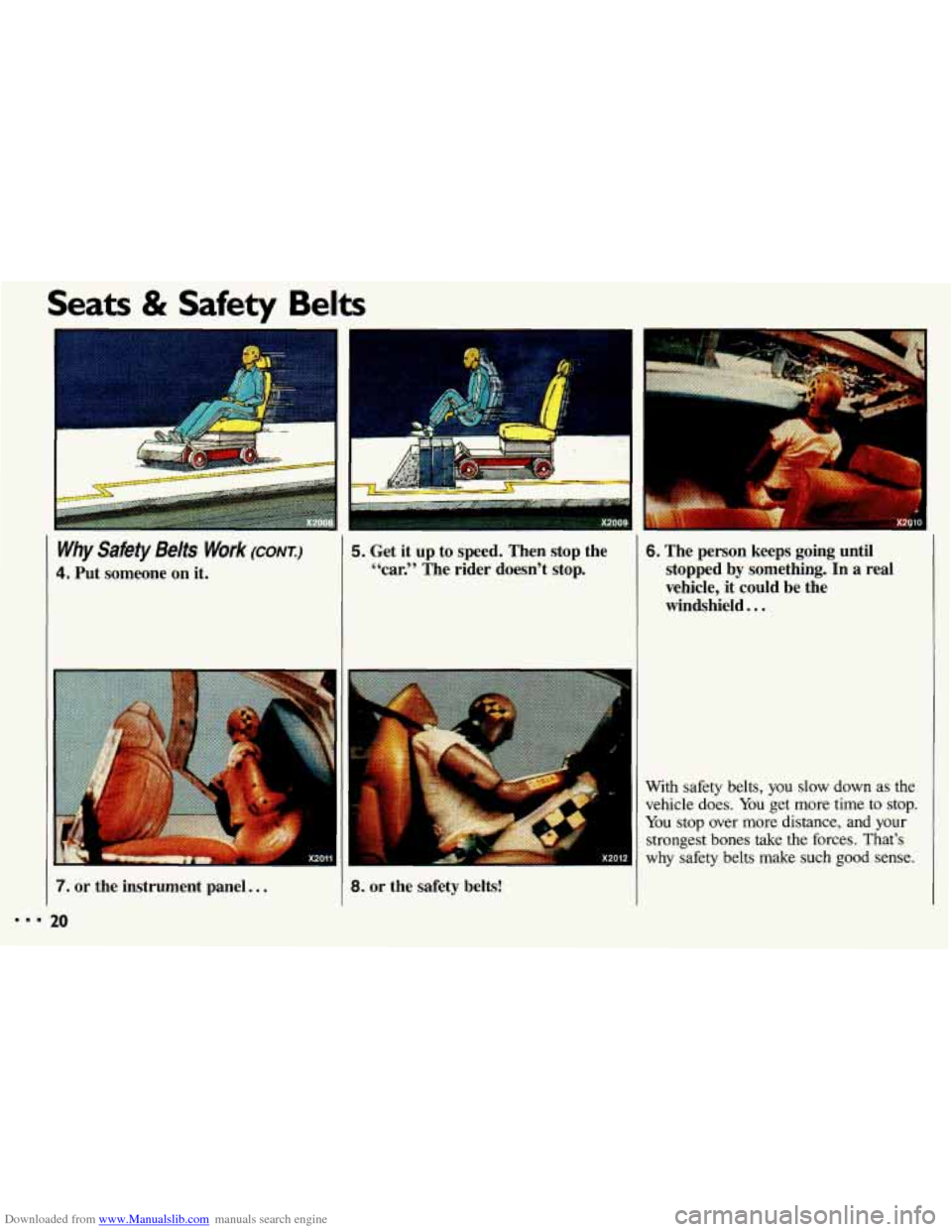
Downloaded from www.Manualslib.com manuals search engine Seats & Safety Belts
I
e
Why Safety Belts Work (CONI:)
4. Put someone on it.
6. The person keeps going until stopped by something. In a real
vehicle,
it could be the
windshield..
.
5. Get it up to speed. Then stop the
44car.” The rider doesn’t stop.
With safety belts, you slow down as the
vehicle does.
You get more time to stop.
You stop over more distance, and your
strongest bones
take the forces. That’s
why safety belts make such
good sense.
7. or the instrument panel.. .
20
8. or the safety belts!
Page 26 of 308

Downloaded from www.Manualslib.com manuals search engine Seats & Safety Belts
Automatic Lap-Shoulder Belt
(CON 1)
And you don't have to unbuckle when
you get out.
Just get into the vehicle. Then close and
lock the door. Adjust the seat
so you can
sit
up straight. (To see how, see the
Index under Seat Controls.)
The lap belt should be worn as low on
the hips as possible. In a crash, this
applies force to
the strong pelvic bones.
And you'd be less likely to slide under
the lap belt. If you slid under
it, the belt
would apply force at your abdomen.
This could cause serious or even fatal
injuries. The shoulder belt should go
over
the shoulder and across the chest.
These parts of the body are best able to
take belt restraining forces.
The safety belt locks
if there's a sudden
stop or a crash. It's possible that
an automatic belt could
keep you from fully opening a door.
That can happen if the door was
slammed shut very hard. Just close the
door all the way, then slowly open it.
If
that doesn't fix it, then your Chevrolet
needs service.
We hope you'll always keep your
automatic belt buckled. However, you
may need to unbuckle it in an
emergency.
Page 28 of 308
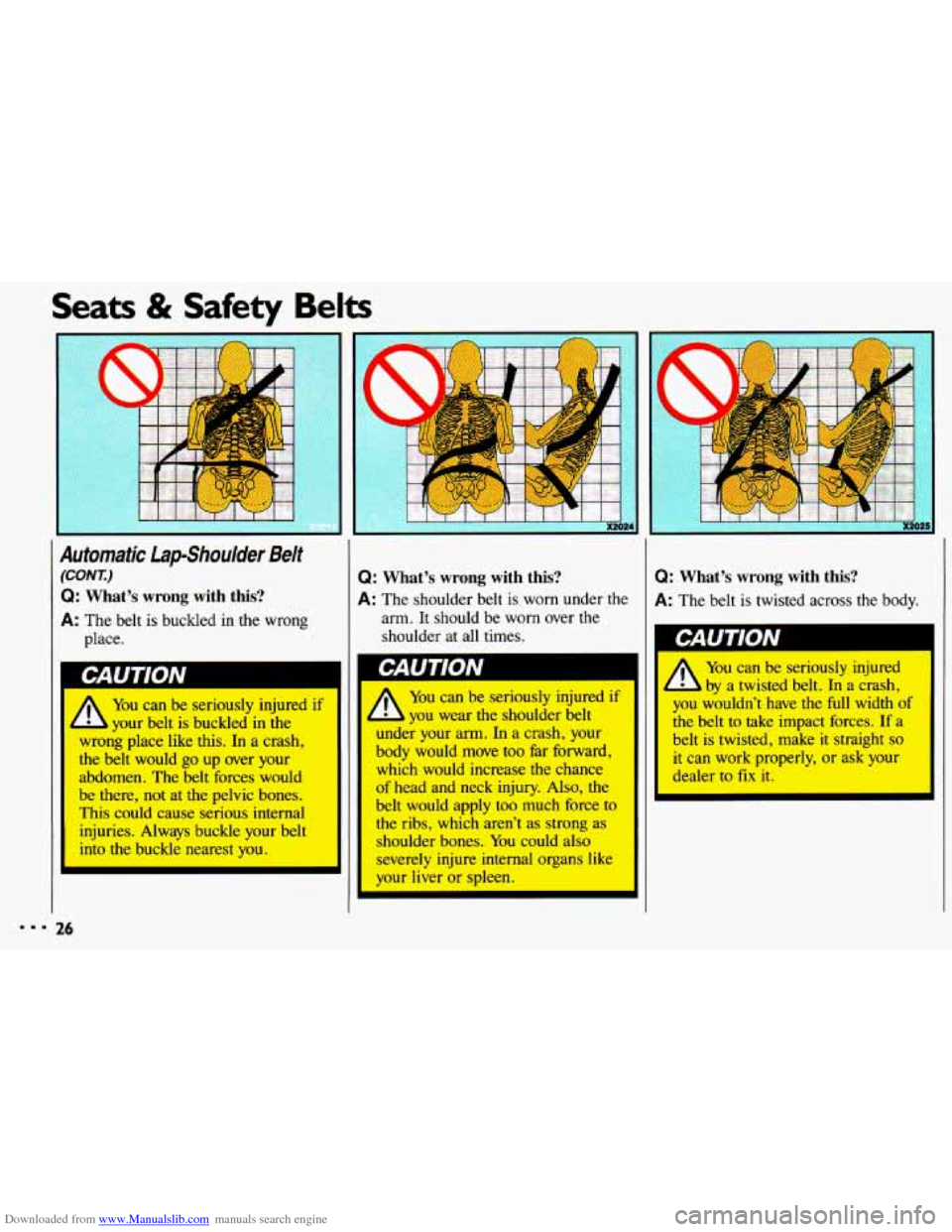
Downloaded from www.Manualslib.com manuals search engine Seats & Safety Belts
Automatic lapshoulder Belt
(CONr.)
Q: What’s wrong with this?
A: The belt is buckled in the wrong
place.
CAUTION I
A
You can be seriously injured if
your belt is buckled
in the
wrong place like this. In a crash,
the belt would
go up over your
abdomen. The belt forces would
be there,
not at the pelvic bones.
This could cause serious internal
injuries. Always buckle your belt
into the buckle nearest
you.
Q: What’s wrong with this?
A: The shoulder belt is worn under the
arm.
It should be worn over the
shoulder at all times.
A
You can be seriously injured if
you wear the shoulder belt
under your arm. In a crash, your
body would move too far forward,
which would increase the chance
of head and neck injury. Also, the
belt would apply too much force to
the ribs, which
aren’t as strong as
shoulder bones. You could alSQ
severely injure internal organs like
your liver or spleen.
Q: What’s wrong with this?
A: The belt is twisted across the body.
‘Ab
You can be seriously injured
a twisted belt.
In a crash,
you wouldn’t have the full width of
the belt to take impact forces. If a
belt
is twisted, make it straight so
it can work properly, or ask your
dealer to
fix it.